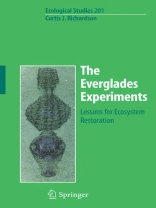In the late 1960s, I worked as a graduate teaching assistant in plant ecology for the late Dr. John Henry Davis at the University of Florida. On one of our visits to the Everglades, he mentioned to me that he had been studying problems of the Everglades since the early 1930s, and that rapid growth in Florida, unless checked, was about to doom the Everglades. He hoped his vegetation survey of the Everglades and his v- etation map could someday be used to help restore the Everglades to some semblance of what it had been prior to the turn of the century. These long-forgotten discussions with Dr. Davis were rekindled when, during a wetland conference in Orlando, Florida in the late 1980s, I was asked what might be responsible for the reported massive invasion of cattails that had been noted during the past decade in the Everglades. Several hypotheses were presented at the meeting, including some preliminary data on the significant inputs of nutrients from agricultural lands and Lake Okeechobee to the north. The shifts in the hydrologic conditions and flow patterns of the existing Everglades were also mentioned. Because of the extensive work on phosphorus and nutrient retention then being done at the Duke University Wetland Center, I was asked in early 1989 to do a preliminary survey and analysis of the ecological status of the Everglades. From this early work, carried out by Dr.
Table of Content
Everglades Ecosystem.- Overview of Gradient Studies and Experiments.- Ecological Status of the Everglades: Environmental and Human Factors that Control the Peatland Complex on the Landscape.- Soil Characteristics of the Everglades Peatland.- Vegetation and Algae of the Everglades Fen.- Nutrient and Hydrologic Gradient Studies.- to the Gradient Studies.- Enrichment Gradients in WCA-2A and Northern WCA-3A: Water, Soil, Plant Biomass, and Nutrient Storage Responses.- Geologic Settings and Hydrology Gradients in the Everglades.- Effects of Hydrologic Management Decisions on Everglades Tree Islands.- Macrophyte Community Responses in the Everglades with an Emphasis on Cattail (Typha domingensis) and Sawgrass (Cladium jamaicense) Interactions along a Gradient of Long-Term Nutrient Additions, Altered Hydroperiod, and Fire.- Algal Responses to Long-Term Nutrient Additions.- Macroinvertebrate Responses to a Gradient of Long-Term Nutrient Additions, Altered Hydroperiod, and Fire.- Historical Changes in Water Quality and Vegetation in WCA-2A Determined by Paleoecological Analyses.- Carbon Cycling and Dissolved Organic Matter Export in the Northern Everglades.- Everglades Experiments.- to a Mesocosm Approach for Establishment of Phosphorus Gradient Experiments.- Water Quality, Soil Chemistry, and Ecosystem Responses to P Dosing.- Macrophyte Slough Community Response to Experimental Phosphorus Enrichment and Periphyton Removal.- Decomposition of Litter and Peat in the Everglades: The Influence of P Concentrations.- Experimental Assessment of Phosphorus Effects on Algal Assemblages in Dosing Mesocosms.- Macroinvertebrate and Fish Responses to Experimental P Additions in Everglades Sloughs.- Plant Community Response to Long-Term N and P Fertilization.- The Effects of Disturbance, Phosphorus, and Water Level on Plant Succession in the Everglades.- Establishment and Seedling Growth of Sawgrass and Cattail from the Everglades.- Modeling Ecosystem Responses to Phosphorus Additions.- Long-Term Phosphorus Assimilative Capacity (PAC) in the Everglades.- Spatial Distributions of Total Phosphorus and Phosphorus Accretion Rates in Everglades Soils.- An Ecological Basis for Establishment of a Phosphorus Threshold for the Everglades Ecosystem.- Lessons for Restoration of the Everglades.- An Ecological Approach for Restoration of the Everglades Fen.About the author
About the Author: Curtis J. Richardson is a professor of Resource Ecology at the Nicholas School of the Environment and Earth Sciences, Duke University, and Director of the Duke University Wetland Center in Durham, NC.
Language English ● Format PDF ● Pages 702 ● ISBN 9780387689234 ● File size 33.0 MB ● Publisher Springer New York ● City NY ● Country US ● Published 2008 ● Downloadable 24 months ● Currency EUR ● ID 2145450 ● Copy protection Social DRM











![Cover of [加]史蒂文·厄尔: 地球气候简史 Cover of [加]史蒂文·厄尔: 地球气候简史](https://static.world-of-digitals.com/thumb_webp/226/9798869051226.webp)
